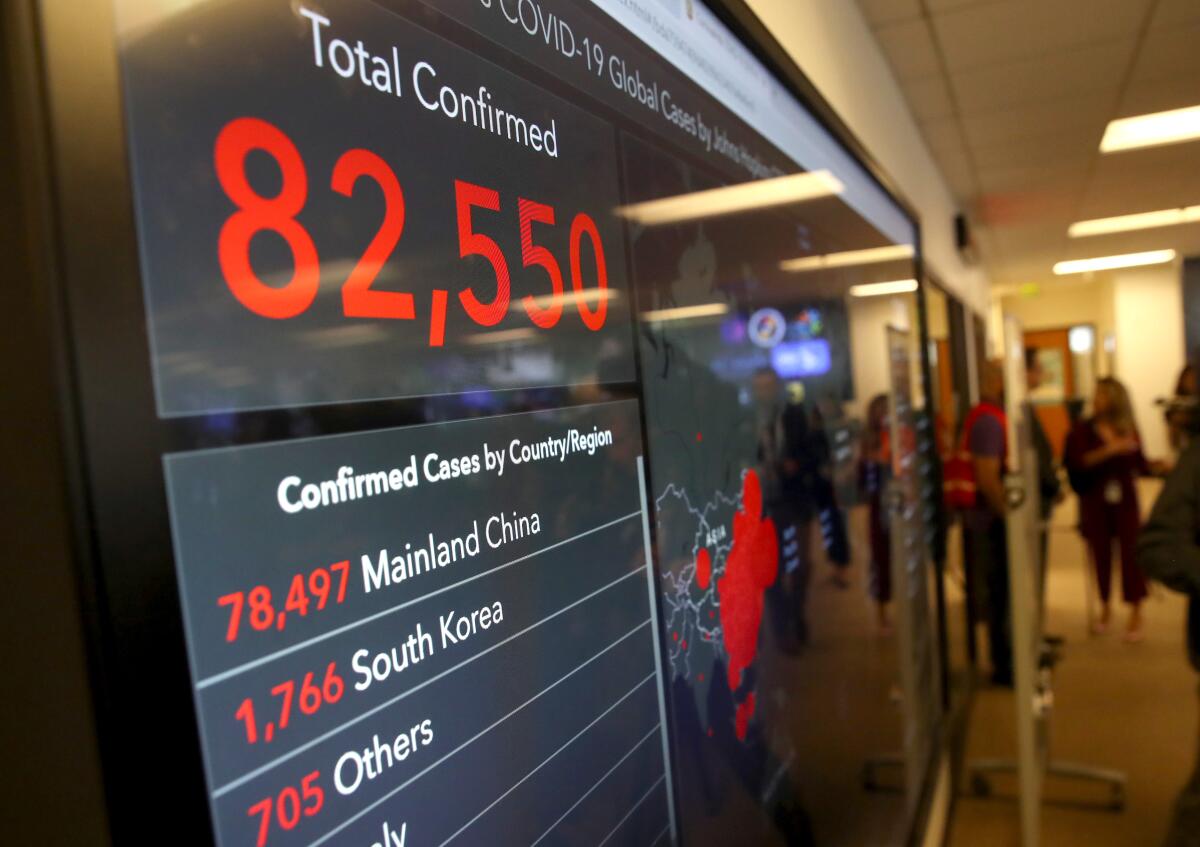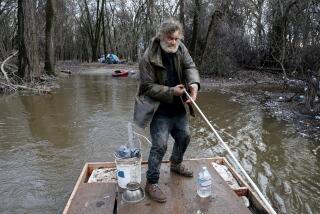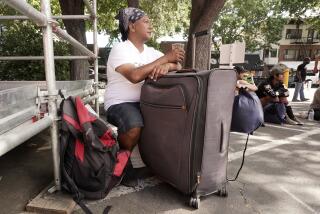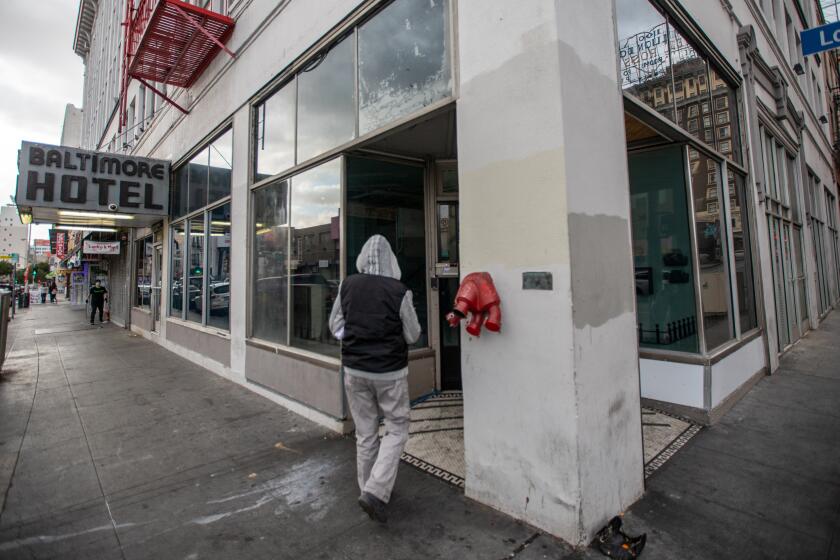Could the coronavirus hit California’s homeless population? Health officials are worried

When a Solano County woman came down with a suspected viral infection and needed treatment, doctors chose to take her to one of the busiest hospitals in Sacramento, not realizing she would become the first person in the nation to be diagnosed with the novel coronavirus without a known cause.
The hospital, UC Davis Medical Center, has an emergency room that’s often filled with homeless patients, their immune systems battered from living in encampments along the capital city’s riverbanks and sidewalks.
The potential for an outbreak among that unsheltered population — both in Sacramento and across California — is beginning to concern some public health officials as the coronavirus spreads.
On Thursday, a student at UC Davis’ main campus, about 30 miles from the hospital, was isolated after exhibiting mild symptoms of the virus. On Friday, a second case of unknown origin was diagnosed in Santa Clara County. And on Saturday, a man died of the coronavirus in Washington state, the first fatality in the U.S.
“I was thinking about it when I was in the … shower [on Thursday] morning, literally,” said Peter Beilenson, director of health services for Sacramento County, where preparations for a potential local outbreak began almost immediately after the Solano County woman was diagnosed. “We’ve been checking on the schools and on the nursing homes and on healthcare facilities, etc., and so I was thinking, ‘What about the homeless?’”
Beilenson and others said homeless people present unique risks and challenges for outbreaks of infectious diseases. Though the number of coronavirus cases remains at only a few dozen in the United States, homeless people, in particular, for multiple reasons could be vulnerable to both a quick spread of the illness and to more severe cases.
People living outdoors often do so in close quarters and lack the ability to maintain basic hygiene, including precautions such as hand washing. They may also face more danger from serious infection because of existing illnesses or frequent use of drugs or alcohol — factors with the potential to make a case of COVID-19 more severe.
Some homeless people also move often, making them both hard to reach for treatment and potentially increasing the spread of the virus if they are carriers.
“Unfortunately, we know that people living in crowded, unsanitary conditions are at increased risk for a variety of infectious diseases,” said Dr. Jeffrey Klausner, professor of medicine and public health at UCLA. “This is definitely a population … with other chronic medical conditions, so should they acquire coronavirus, they are potentially at risk for more serious complications.”
With an unprecedented number of people living on the streets of California, and large encampments now common in urban areas, coronavirus has created a situation unlike that of previous outbreaks of communicable disease.
And that has led to an uncertain scenario in which planning is happening as the outbreak evolves and public health officials are dealing with the possible complexities of managing a pandemic in the middle of a homelessness crisis.
At the state level, however, the Department of Public Health has indicated that it does not see the homeless population as particular point of concern as of now.
“Persons experiencing homelessness are not likely to have any particular risk for COVID-19 related to international travel or exposure to recent travelers,” the agency said Friday in a statement to The Times.
Jessica Lin, a researcher with the Georgetown Center for Global Health Science and Security who has worked with homeless people, said that if the coronavirus reaches homeless people, it would present a potentially fast-moving hazard — both to those living in encampments and to outreach workers, nearby residents and health providers.
Preparing for that contingency could help mitigate it, she said, if only by training front-line providers to recognize symptoms.
Not doing so, Lin said, “puts all of them at risk.”
“Maybe right now [homeless people] are not interacting with people who have traveled ... but once it spreads to the general or local population, it will be a concern,” she added.
Some counties are being proactive about the health of their unsheltered residents by reaching out to homeless people to tell them about the coronavirus and screen them for infection.
In Sacramento, Beilenson said homeless outreach workers were told last week to ask a series of health questions in an attempt to identify people who might have COVID-19. But the plan was abandoned when it became clear that too many people had symptoms associated with many forms of illness, not just the coronavirus.
“So many people are coughing and having other symptoms that could be anything,” Beilenson said.
Still, he said, the county plans on being aggressive by bringing homeless residents who appear to be seriously ill into treatment centers that will be prepared to handle patients who might be contagious.
One point of concern if the virus reaches homeless people is where patients could be isolated to stem a wider outbreak.
“If or when it spreads to that population, how do we find places to quarantine a population that we don’t now have space for in many cases?” Lin asked.
So far, public health officials in Solano and Sacramento counties are relying largely on home-based quarantines for those who may have been exposed.
Beilenson said the plan in Sacramento is to use a local motel if homeless people need to be isolated because shelters “are not set up for that.” In the past, motels have been used in suspected cases of tuberculosis.
In Los Angeles, the Department of Public Health planned to meet with homeless service providers and hold a briefing with the managers of shelters and other interim housing to discuss strategies for reducing the transmission of the virus and managing a quarantine if it becomes necessary.
And in San Francisco, homeless people are “among the priority populations” that have been deemed especially vulnerable to the coronavirus, according to the county health department, which declared an emergency this week, although it has not yet seen any local cases.
That declaration means “the Department of Homelessness and Supportive Housing is now part of the city’s Emergency Operations Center and is actively involved in planning and preparation for the population of people experiencing homelessness,” county officials said in a statement.
Beilenson said he believed the virus is nearly certain to hit more people in the general community.
“It’s going to spread,” said Beilenson. “Definitely we will have more cases here.”
Klausner, the UCLA doctor, said he believed it would be useful to be more proactive about giving flu shots to homeless people. The flu, he pointed out, is much more prevelant than COVID-19, and preventing those cases in the homeless community has the dual benefit of improving overall health and keeping flu cases out of emergency rooms.
“On a day-to-day basis, they are at a much greater risk for influenza,” he said.
But few doubt the overall vulnerability of California’s homeless population. Last year, there was an outbreak of typhus in the squalor near skid row. In other places, including San Diego, homeless residents have seen cases of hepatitis A, and Klausner said homeless people in Santa Monica recently had a few cases of trench fever, which is transmitted by body lice.
“We are a confined community,” said Edward Linwood, who lives in a single-occupancy hotel near skid row and added that many nearby neighbors are elderly or disabled. “If one person gets it, it’s going to spread ... Everything that has affected L.A. comes here.”
Times staff writer Gale Holland contributed to this report.







